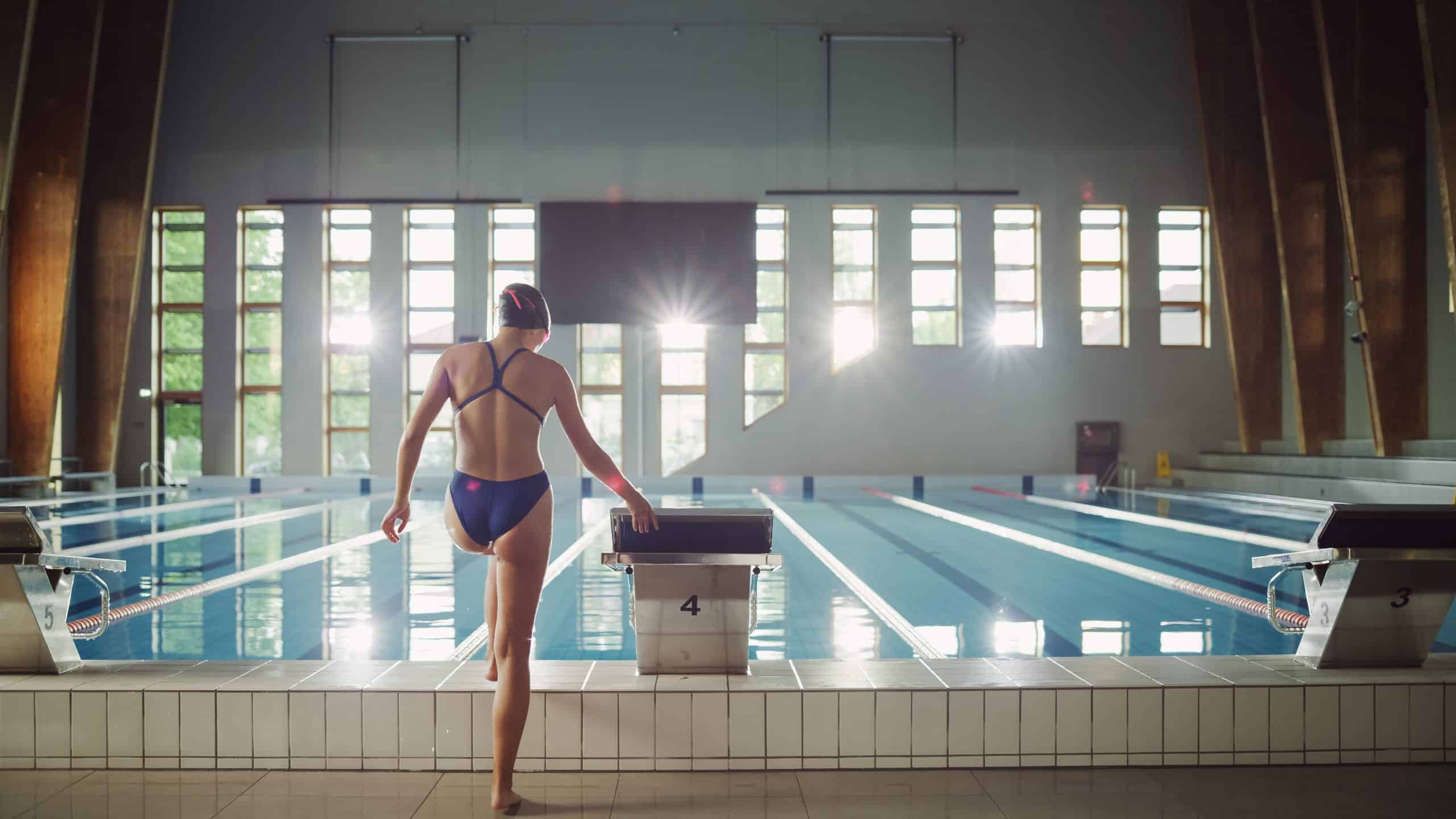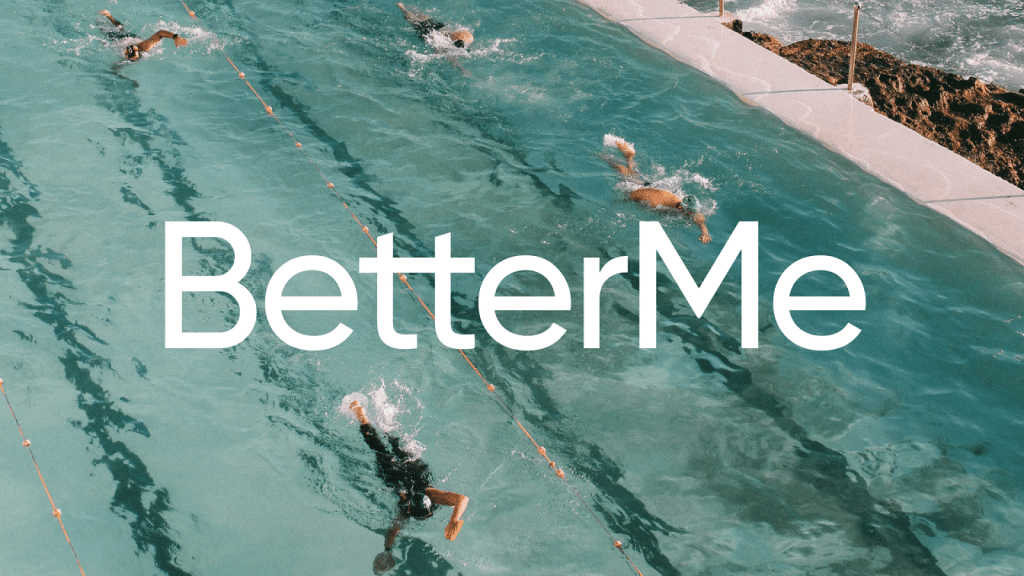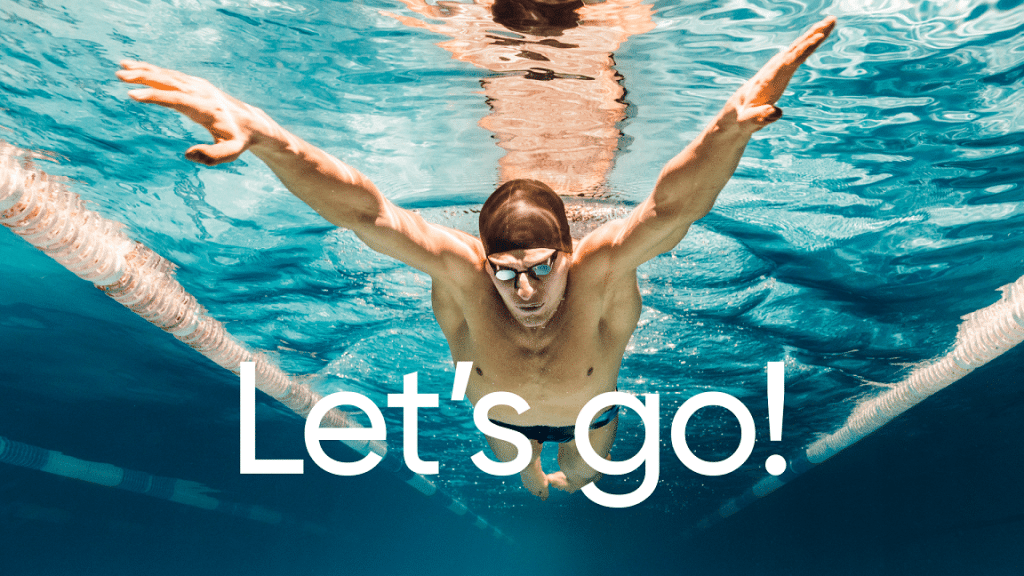If you’ve recently swum a lap, found yourself out of breath, and wondered why swimming isn’t as effortless as when you were a kid, it’s time to reconsider how you view this classic form of exercise. Swimming is a full-body workout that can burn significant calories due to the amount of effort it requires – it’s not just about lazily paddling around!
The energy that you expend when swimming is dependent on your speed, efficiency, and the type of stroke you use. This high-energy aquatic workout engages every muscle group, which offers you a holistic fitness experience that is both challenging and refreshing.
In this guide, we’ll explore the science behind swimming and how many calories it burns, which will help you transform your casual laps into a rigorous calorie-burning session.
How Many Calories Does Swimming Burn?
How many calories does swimming burn is largely dependent on an individual’s weight and workout intensity. For a 155-pound individual, swimming at a moderate pace for an hour could burn approximately 446 calories. However, if the same person were to swim laps at a vigorous intensity for an hour, they could potentially burn approximately 744 calories (2).
Understanding MET
Before we delve into the specifics, it’s important to first understand what MET (Metabolic Equivalent of Task) is. MET is a unit that estimates the amount of energy the body uses during physical activity compared to resting. One MET is defined as the energy cost of sitting quietly (5).
Using MET to Determine Calories Burned While Swimming
In order to calculate the number of calories that are burned while swimming, you must know the MET value of the swimming activity, your weight in kilograms, and the duration of the activity in hours (4). The general formula is:
Calories Burned = MET * Weight in Kg * Duration in Hours
Different styles of swimming have different MET values. For example, butterfly swimming, which is one of the most intense forms of swimming, has a higher MET value than a slower, more leisurely stroke.
BetterMe is your fast-track ticket to a long-lasting weight loss! Tailor your fitness journey and maximize your results with just a couple of swipes!
Calories Burned Swimming Different Strokes, Distances, and Times
We will now use the above formula to calculate the calories burned for various distances and styles of swimming for a person who weighs 70 kg. It should be noted that the values provided are all estimates and actual values can vary based on factors such as individual metabolism and swimming efficiency.
- Butterfly Swimming: Assuming a MET value of 10, a 30-minute swim will burn approximately 350 calories
- Calories Burned Swimming 1,000m: For freestyle swimming with a MET value of 7, a 30-minute swim (average speed) will burn approximately 245 calories
- Freestyle Swimming Calories Burned: A 30-minute session of freestyle swimming, with a MET value of 7, will burn approximately 245 calories
- Calories Burned Swimming 1km in 30 Minutes: With an average freestyle MET value of 7, you will burn approximately 245 calories
- Calories Burned Swimming 300m: For a quick, intense 5-minute swim at a fast pace (MET value of 10), you will burn approximately 58 calories
- Calories Burned Swimming vs Running: Running has a MET value of approximately 8 (for a 6 mph pace), so a 30-minute run will burn approximately 280 calories, which is slightly more than a freestyle swim
- Calories Burned Swimming 100m: Assuming a fast pace with a MET value of 10, a 2-minute swim will burn approximately 21 calories
- Calories Burned Swimming 1 Mile: If you swim this in 60 minutes, considering a MET value of 7 for freestyle swimming, you will burn close to 490 calories
Enhancing Calorie Burn with Water Resistance
In addition to different strokes and distances, another important factor for determining the calories burned during swimming is water resistance. When you are swimming, your body is constantly working against the resistance of the water, which is approximately 800 times greater than air resistance. This resistance acts as a natural weight resistance training, intensifying your workout, and increasing calorie burn (1).
The Role of Temperature in Swimming Calorie Burn
The temperature of the water you’re swimming in can also affect the number of calories you burn. Swimming in colder water requires the body to work harder in order to maintain its core temperature, thereby burning more calories (3). However, this should be approached with caution as prolonged exposure to cold water can cause hypothermia.
Swimming vs Other Forms of Exercise
When comparing swimming to other forms of exercise, it stands out in terms of the number of calories burned and the low impact it has on the joints in the body. Unlike running or weight training, swimming for seniors is a non-weight-bearing exercise, which makes it an excellent choice for those with joint issues or who are recovering from injuries.
What Is The Best Swimming Stroke for Exercise?
When it comes to deciding the best swimming stroke for exercise, this is dependent on your personal fitness goals and current swimming ability. Every stroke has its own unique benefits:
- Freestyle (Front Crawl): This is the fastest and most common stroke, which makes it great for overall fitness. It works the shoulders, back, and leg muscles, while also providing an excellent cardiovascular workout.
- Breaststroke: This stroke is often considered to be the easiest to learn, which makes it ideal for beginners. It provides a full-body workout that targets the chest, arms, abs, and legs. While it may be slower and burns fewer calories than other strokes, it is ideal for improving lung capacity and building endurance.
- Backstroke: This stroke is excellent for improving posture as it works the back and shoulder muscles. It’s also easier to breathe during backstroke as your face is out of the water, which makes it a good choice for those who are looking to build stamina.
- Butterfly: This is the most challenging stroke of all, but it is also the most effective for burning calories. It engages the core, chest, arms, shoulders, and back muscles and provides an intense full-body workout.
If you’re looking for speed and a total body workout, freestyle is most likely your best bet, but if you’re a beginner, then breaststroke may be more appropriate.
Backstroke is perfect for those who wish to focus on their back muscles and posture, while butterfly is excellent for a high-intensity, calorie-burning workout.
However, the best approach to exercise is often to incorporate all four strokes into your routine, as this will ensure a well-rounded workout targeting different muscle groups and keep your routine interesting.
Read more: Planning To Visit An Exercise Swimming Pool? Here Are 8 Moves You Should Try.
Where Do You Lose Weight When Swimming
As with any other form of exercise, swimming will not specifically target fat loss in certain areas of the body. When you lose weight, this is a systemic process that affects the entire body. The regions where you’ll initially see weight loss are largely determined by your genetics and gender. However, swimming is a full-body workout that will help you shed pounds and tone up all over.
Upper Body
Swimming engages the muscles in the arms, shoulders, and back. As you glide through the water, your arms are constantly working to propel your body forward. This can result in increased muscle tone and definition in these areas over time. While this doesn’t necessarily translate directly to fat loss in the upper body, increased muscle mass will contribute to an overall leaner appearance.
Core
The core plays an essential role in maintaining stability and coordinating movements while swimming. Every stroke requires a strong engagement of the abdominal and lower back muscles. Regular swimming can strengthen these muscles, potentially resulting in a stronger and more toned midsection.
Lower Body
Your legs and glutes are also hard at work during swimming. Kicking helps drive your body forward and maintain buoyancy. This constant movement can result in toned thighs and firmer glutes. Again, while swimming won’t specifically burn fat in these areas, the increased muscle tone will contribute to a leaner look.
Does Swimming Tone Your Arms?
Yes, swimming can help tone your arms. It is a full-body workout that requires the use of key muscle groups, which include those in your arms. While swimming, you constantly use your arms to propel yourself through the water, which engages and helps strengthen the biceps, triceps, and shoulder muscles.
Different swimming strokes target your arm muscles differently. For example, front crawl and breaststroke are particularly good for toning the arms. Front crawl, which is often referred to as freestyle, primarily works the triceps and the shoulder muscles.
At the same time, breaststroke engages both the biceps and triceps, which gives you a balanced arm workout. In addition, the resistance the water provides during swimming is another factor that helps tone and strengthen your arm muscles.
How To Maximize Calorie Burn from Swimming
To maximize calorie burn from swimming, there are several strategies that you can employ:
1. Use Equipment
Utilizing equipment such as fins, paddles, and snorkels can help increase your caloric burn. These tools add resistance and work your muscles harder, which results in a higher energy expenditure.
2. Longer, Intense Sessions
Swimming for longer periods, ideally for at least 30 minutes to an hour, and maintaining a high intensity throughout can significantly increase your calorie burn. The longer and harder you swim, the more calories you will burn.
3. Vary Your Routine
Changing up your routine can prevent your body from becoming too efficient in the water, which reduces calorie burn. Try different strokes, speeds, and techniques to keep your body guessing and your calorie burn high.
4. Set Goals
Setting realistic goals can also help increase calorie burn. This can involve swimming a certain number of laps within a specific time frame or aiming to swim faster or further each session.
When it comes to weight loss, progress is made by inches, not miles, so it’s much harder to track and a lot easier to give up. BetterMe app is your personal trainer, nutritionist and support system all in one. Start using our app to stay on track and hold yourself accountable!
5. Swim Before Eating
Swimming before eating, particularly in the morning, may lead to your body utilizing its fat stores as an alternative fuel source as your body’s carbohydrate stores will be low. This method is useful for burning stored body fat, but it’s important to note that swimming in a fasted state may not be suitable for everyone and could negatively impact performance, thereby compromising your results.
6. Join a Swim Class
Joining a swim class can provide structure and motivation, which will encourage you to push yourself harder and burn more calories.
7. Pay Attention to Form
Maintaining good form will prevent injury while also ensuring that you swim efficiently and effectively, which can result in a higher calorie burn.
Frequently Asked Questions
Is swimming a good way to lose weight?
A: Yes, swimming is an excellent way to lose weight. It’s a full-body workout that burns calories and builds muscle, both of which are essential for weight loss. The intensity of your swim sessions, the duration, and the stroke you choose can all influence the amount of calories you burn and how many pounds you will lose.
Why do swimmers burn so many calories?
A: Swimming burns a lot of calories as it works several muscle groups simultaneously and requires constant movement. Together with the water resistance that is faced while swimming, this makes it a highly effective calorie-burning exercise.
In addition, the body uses more energy to maintain its core temperature in cooler water, which adds to the calorie burn.
What exercise burns the most belly fat in the pool?
A: All swimming strokes are effective in the promotion of weight loss, which supports a reduction in belly fat. They engage the core muscles and increase the heart rate, which helps to burn calories and reduce body fat.
It is important to remember that while these exercises can help tone your abdominal muscles, they will not specifically target belly fat. Fat loss occurs systemically, not in any specific area.
How many laps in a pool is a good workout?
A: The number of laps that constitute a good workout will vary significantly depending on your fitness level, the length of the pool, and your swimming goals.
For beginners, 20 to 30 minutes of continuous, moderate-paced swimming (which equates to approximately 20 laps of a standard 25-yard pool) is a good starting point. However, if you are a complete beginner, you should start with a lot less. More advanced swimmers may wish to aim for 60 minutes or more.
Why am I gaining weight from swimming?
If you’re gaining weight from swimming, this could be due to increased muscle mass. Swimming is a resistance exercise that builds muscle, and muscle is known to weigh more than fat. It is also possible that swimming is increasing your appetite, resulting in you eating more calories than you’re burning.
You should make sure you pair your swimming routine with a balanced diet to ensure you’re fueling your body properly to support your activity levels without overeating.
The Bottom Line
Swimming is an incredibly effective way of burning calories and improving overall fitness. By manipulating factors including stroke type, speed, water resistance, and temperature, you can maximize your swimming workouts for weight loss. Not only is swimming an excellent way to stay in shape, it also offers a refreshing change from other, more traditional forms of exercise.
DISCLAIMER:
This article is intended for general informational purposes only and does not serve to address individual circumstances. It is not a substitute for professional advice or help and should not be relied on for making any kind of decision-making. Any action taken as a direct or indirect result of the information in this article is entirely at your own risk and is your sole responsibility.
BetterMe, its content staff, and its medical advisors accept no responsibility for inaccuracies, errors, misstatements, inconsistencies, or omissions and specifically disclaim any liability, loss or risk, personal, professional or otherwise, which may be incurred as a consequence, directly or indirectly, of the use and/or application of any content.
You should always seek the advice of your physician or other qualified health provider with any questions you may have regarding a medical condition or your specific situation. Never disregard professional medical advice or delay seeking it because of BetterMe content. If you suspect or think you may have a medical emergency, call your doctor.
SOURCES:
- Health benefits of swimming (2022,healthdirect.gov.au)
- How Many Calories Can I Burn While Swimming? (2019,usms.org)
- Increased caloric intake soon after exercise in cold water (2005,nih.gov)
- METABOLIC EQUIVALENTS FOR WEIGHT LOSS: WHAT ARE THEY & HOW TO CALCULATE THEM (n,d,nasm.org)
- Staying Active (n,d,harvard.edu)












